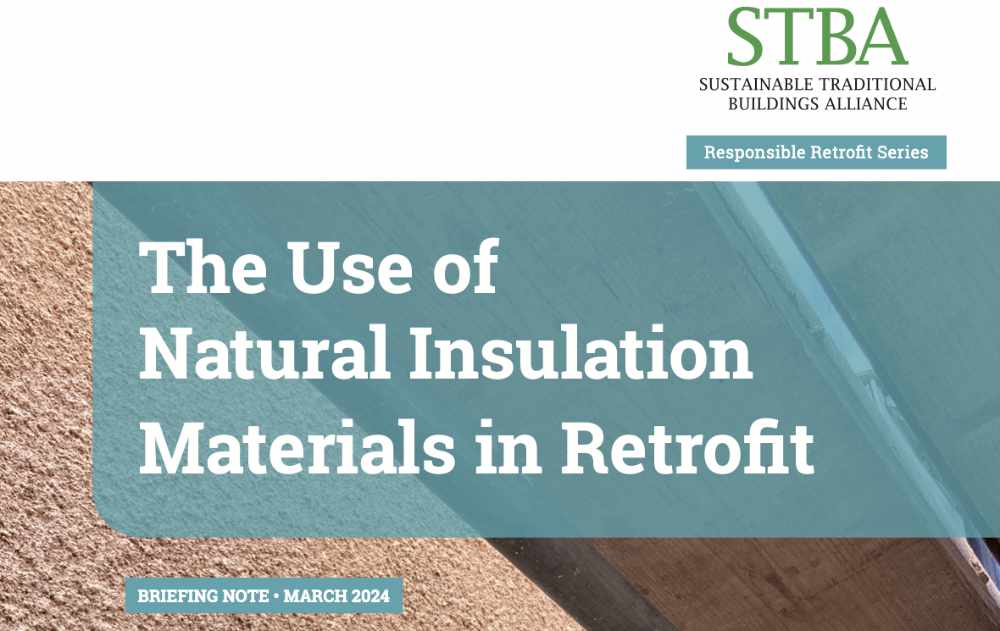Natural materials for retrofits
Contents |
[edit] Championing natural materials to de-risk retrofit
In a new paper, the Sustainable Traditional Buildings Alliance (STBA), which is hosted by the Sustainable Development Foundation (SDF), has identified a number of barriers to best practice retrofit of traditional solid wall buildings, and calls for steps to be taken to remove these barriers, facilitate sustainable retrofit, and ensure the use and enjoyment of our heritage buildings for years to come.
25% of the UK’s building stock is of traditional construction, meaning they are solid-walled and rely on a vapour-open strategy to manage moisture. For these buildings, the unconsidered use of modern impermeable materials can introduce a risk of moisture accumulation and resultant damp and mould.
The paper, The Use of Natural Insulation Materials in Retrofit, explores the energy and carbon characteristics of natural materials, their moisture handling characteristics, and the regulatory context.
On the basis of its analysis, it calls for five actions from government that will help enable best practice retrofit of traditional buildings. The recommendations are to:
- Eliminate the requirement for a 25-year guarantee on solid wall insulation from current Trustmark lodgment rules. Consider introducing a requirement for a 10-year guarantee, or use public funds to expedite longer-term guarantees for natural materials.
- Work with the insurance industry to help them understand the ways in which natural materials can help de-risk retrofit.
- Ensure that the Government’s own guidance on internal wall insulation across all typologies is well understood by all relevant policy officers.
- Establish a broad range of metrics for retrofit materials, to encompass: resource scarcity, sequestered carbon, embodied energy, water use and embodied pollution. EPDs (Environmental Performance Declarations) or Materials Passports could be considered as a starting point.
- Establish a broad range of metrics for retrofit, including benefits to health, welfare, net energy savings, water efficiency and sustainable drainage, and include wider community benefits such as employment, green spaces, and social cohesion.
This article appears on the SDF website as 'Championing natural materials to de-risk retrofit' from April 2024.
[edit] About SDF
The Sustainable Development Foundation aims to drive the property and construction industry towards exemplary sustainability practices. In order to achieve this, the SDF has two main roles: as a Think Tank and as part of an Alliance.
For further information visit: https://sdfoundation.org.uk/
[edit] About STBA
The Sustainable Traditional Buildings Alliance is a collaboration of organisations that acts as a forum for sustaining and improving solid-wall buildings.
The STBA develops policy, guidance and training to minimise risks and maximise benefits to traditional buildings and their owners with a focus on five key areas; the health of the occupants, the health and durability of the building fabric, the energy consumption attributed to the building/occupant, the impact on our communities and culture and the impact on the natural environment
For further information visit: https://stbauk.org/
[edit] Related articles on Designing Buildings
- Definitions of retrofitting.
- Energy efficiency of traditional buildings.
- Energy efficiency retrofit training videos.
- Energy Performance Certificates.
- Fabric first.
- Government urged to include home energy retrofits in Industrial Strategy.
- Home Energy Masterplan.
- Households Declare.
- How to deal with retrofit risks.
- National Retrofit Strategy NRS.
- New energy retrofit concept: 'renovation trains' for mass housing.
- PAS 2035.
- PAS 2038:2021 Retrofitting non-domestic buildings for improved energy efficiency.
- Refurbishment.
- Renovation.
- Renovation v refurbishment v retrofit.
- Retrofit and traditional approaches to comfort.
- Retrofit coordinator.
- Retrofit, refurbishment and the growth of connected HVAC technology.
- Retrofitting solar shading.
- Shallow retrofit.
- Step-by-step retrofit.
Featured articles and news
BSRIA Statutory Compliance Inspection Checklist
BG80/2025 now significantly updated to include requirements related to important changes in legislation.
Shortlist for the 2025 Roofscape Design Awards
Talent and innovation showcase announcement from the trussed rafter industry.
OpenUSD possibilities: Look before you leap
Being ready for the OpenUSD solutions set to transform architecture and design.
Global Asbestos Awareness Week 2025
Highlighting the continuing threat to trades persons.
Retrofit of Buildings, a CIOB Technical Publication
Now available in Arabic and Chinese aswell as English.
The context, schemes, standards, roles and relevance of the Building Safety Act.
Retrofit 25 – What's Stopping Us?
Exhibition Opens at The Building Centre.
Types of work to existing buildings
A simple circular economy wiki breakdown with further links.
A threat to the creativity that makes London special.
How can digital twins boost profitability within construction?
The smart construction dashboard, as-built data and site changes forming an accurate digital twin.
Unlocking surplus public defence land and more to speed up the delivery of housing.
The Planning and Infrastructure Bill
An outline of the bill with a mix of reactions on potential impacts from IHBC, CIEEM, CIC, ACE and EIC.
Farnborough College Unveils its Half-house for Sustainable Construction Training.
Spring Statement 2025 with reactions from industry
Confirming previously announced funding, and welfare changes amid adjusted growth forecast.
Scottish Government responds to Grenfell report
As fund for unsafe cladding assessments is launched.
CLC and BSR process map for HRB approvals
One of the initial outputs of their weekly BSR meetings.
Building Safety Levy technical consultation response
Details of the planned levy now due in 2026.
Great British Energy install solar on school and NHS sites
200 schools and 200 NHS sites to get solar systems, as first project of the newly formed government initiative.
600 million for 60,000 more skilled construction workers
Announced by Treasury ahead of the Spring Statement.


























